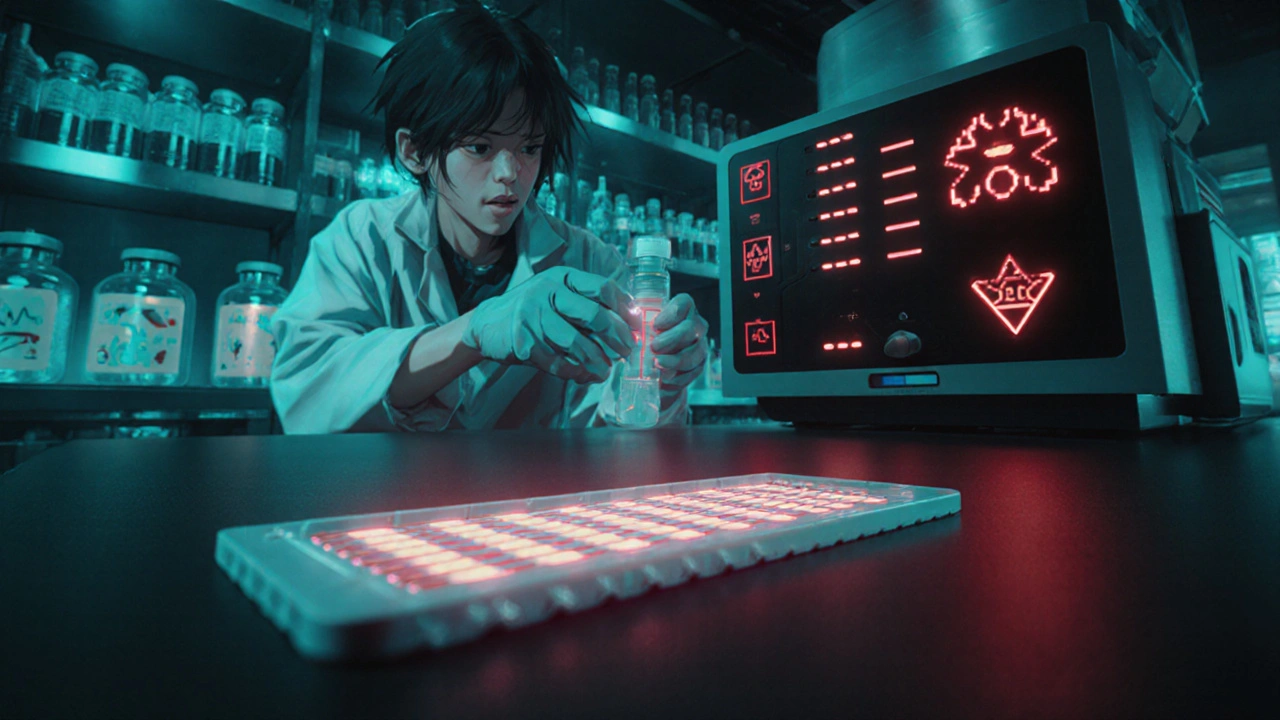HIV Test Selection Guide
Find Your Recommended HIV Test
This tool helps you determine which HIV test is most appropriate for your situation based on your exposure timeline and circumstances. Results are based on current medical guidelines.
Recommended Test
Select your exposure date and situation to see recommended tests.
Note: This tool is for informational purposes only. Always consult with a healthcare professional for accurate diagnosis and treatment. HIV tests are most reliable after the window period.
Key Takeaways
- HIV‑1 and HIV‑2 infections are detected mainly through antibody, antigen, and nucleic‑acid tests.
- ELISA, rapid diagnostic tests, and PCR each have distinct strengths and ideal use‑cases.
- Combination (fourth‑generation) tests catch infection earlier by spotting both antibodies and p24 antigen.
- Result interpretation depends on test type, timing of exposure, and confirmatory testing.
- Emerging point‑of‑care technologies are shrinking the window period and expanding access.
When you step into a clinic and ask for an HIV test, the procedure that determines whether you carry HIV‑1 or HIV‑2, the lab follows a chain of science most people never see. Understanding what actually happens inside that tiny vial helps you trust the result and choose the right test for your situation.
Understanding HIV‑1 vs HIV‑2
Both viruses belong to the lentivirus family, but they differ in geographic spread and disease progression. HIV‑1 test detects the more common strain, responsible for the global pandemic, while HIV‑2 test focuses on the less transmissible variant found mainly in West Africa. Modern assays are designed to screen for both, but the nuances matter when you interpret a result from a traveler or someone from an endemic region.
How Antibody Tests Work
Traditional screening relies on the body’s immune response. After infection, the immune system produces antibody proteins that specifically recognize HIV‑1 or HIV‑2. Enzyme‑linked immunosorbent assay (ELISA a laboratory technique that uses enzyme‑linked antibodies to produce a measurable color change) is the workhorse for high‑volume labs. A patient’s serum is added to a plate coated with HIV antigens; if antibodies are present, they bind and trigger a reaction that a machine reads as positive or negative.
ELISA’s sensitivity exceeds 99 % after the typical “window period” of 3-4 weeks. However, it can miss very recent infections because antibodies haven’t peaked yet. That’s why many clinics pair ELISA with a confirmatory test such as Western blot.
How Antigen/Combination Tests Work
Fourth‑generation assays combine antibody detection with measurement of the p24 antigen a viral protein released early in infection. The p24 capsid protein appears in the blood before antibodies, shrinking the window period to roughly 2 weeks. A rapid diagnostic test (Rapid diagnostic test a point‑of‑care cartridge that gives a visual result within 20 minutes) can now provide both signals on a single strip, making it possible to catch acute infections in community settings.
These combination tests are recommended for anyone who might have been exposed within the last month, especially after a high‑risk event.

The Role of PCR
Polymerase chain reaction (PCR a molecular method that amplifies tiny amounts of viral RNA or DNA for detection) goes a step further. Instead of waiting for the body to produce antibodies, PCR looks directly for viral genetic material. This makes it the gold standard for early diagnosis, newborn screening, and monitoring viral load during treatment.
There are two main flavors:
- RNA PCR (viral load) - quantifies the amount of circulating virus, guiding therapy decisions.
- DNA PCR (proviral DNA) - used for early infant diagnosis because maternal antibodies can mask serology.
Because PCR requires specialized equipment, it’s typically performed in centralized labs, but newer cartridge‑based platforms are bringing it closer to the point‑of‑care.
Interpreting Results: From Screening to Confirmation
A positive screening result-whether from ELISA, a rapid test, or a fourth‑generation assay-doesn’t automatically mean infection. Confirmatory testing is required to rule out false‑positives, which can arise from cross‑reactivity with other infections or vaccinations.
Western blot remains a classic confirmatory method: it separates HIV proteins on a gel, then adds patient serum to see which proteins generate a line. Modern labs now often use an immunoblot or an HIV‑1/HIV‑2 differentiation assay, which tells you which virus you carry.
If the confirmatory test is negative, the lab usually repeats the screening test after a few weeks to catch any late seroconverters.
Choosing the Right Test for Your Situation
- Routine screening in a low‑risk adult - a rapid diagnostic test or ELISA is sufficient.
- Recent high‑risk exposure (within 30 days) - a fourth‑generation combo test or nucleic‑acid test (PCR) gives the earliest detection.
- Pregnant women - all guidelines recommend a fourth‑generation assay plus a confirmatory test if positive.
- Newborns - PCR is the only reliable method because maternal antibodies persist for months.
Cost and turnaround time also matter. Rapid tests return results in under 20 minutes and can be done at a community outreach site, while ELISA and PCR require lab infrastructure but provide higher sensitivity for early infection.

Emerging Technologies and the Future of HIV Testing
Researchers are pushing the window period even shorter with ultrasensitive antigen‑detecting platforms, some claiming detection within 5-7 days post‑exposure. Meanwhile, microfluidic chips and smartphone‑linked readers are turning a pocket‑size device into a laboratory, enabling self‑testing with results uploaded instantly to a health portal.
These advances promise broader access, especially in low‑resource settings, but they also raise new questions about data privacy, result counseling, and linkage to care.
Comparison of Common HIV Tests
| Test Type | Detects | Window Period | Typical Setting | Result Time |
|---|---|---|---|---|
| ELISA (3rd‑gen) | Antibody (HIV‑1, HIV‑2) | 3-4 weeks | Laboratory | Hours |
| Rapid Diagnostic Test | Antibody ± Antigen (4th‑gen) | 2-4 weeks | Point‑of‑care | 15-20 min |
| Combination (4th‑gen) Lab | Antibody + p24 Antigen | ~2 weeks | Laboratory | Same day |
| PCR (RNA) | Viral RNA (viral load) | 5-7 days | Reference Lab | 1-2 days |
| Western/Immunoblot | Confirmatory antibodies | Post‑screening | Laboratory | Days |
Frequently Asked Questions
Frequently Asked Questions
How soon after exposure can an HIV test detect infection?
A nucleic‑acid test (PCR) can spot the virus in 5-7 days, antigen‑based fourth‑generation tests in about 2 weeks, and antibody‑only tests need 3-4 weeks.
Can a rapid test differentiate between HIV‑1 and HIV‑2?
Most point‑of‑care rapid tests report a combined result. If it’s positive, a follow‑up lab test (often a differentiation immunoblot) tells you which virus is present.
Why is confirmatory testing required after a positive screening?
Screening assays are highly sensitive but can give false‑positives due to cross‑reactivity. Confirmatory tests, such as Western blot or a differentiation assay, provide higher specificity and identify the exact HIV type.
Is it safe to use a home‑based HIV test?
Home kits are typically fourth‑generation rapid tests with clear instructions. They’re reliable when used after the window period, but a positive result should always be confirmed at a clinic.
How do doctors decide which test to order?
The choice depends on risk timing, patient age (e.g., newborns need PCR), setting (clinic vs. community outreach), and resource availability. Guidelines usually start with a rapid or fourth‑generation test, followed by PCR or confirmatory immunoblot if needed.


Comments (5)
Sarah Hanson October 18 2025
Ths overview is thorough; the distinction between antibody‑only and combination assays is crucial for clinicians.
Nhasala Joshi November 2 2025
Wow, the rapid‑diagnostic kits are practically a double‑edged sword 🤯-they empower communities but also open the door for shadow labs to slip in counterfeit reagents, a classic pharma‑big‑tech collusion scenario 😱. The surge of microfluidic chips backed by unnamed “silicon valley” investors raises red flags about data harvesting and bio‑surveillance-watch the fine print! 🚨
Brian Van Horne November 17 2025
The PCR section neatly captures why nucleic‑acid amplification outranks serology for newborn diagnosis, especially given maternal antibody interference.
Norman Adams December 1 2025
Oh, because we all have a personal laboratory in our garage to run fourth‑generation ELISAs, right? Nothing says “cutting‑edge” like waiting days for a Western blot you’ll never read.
Margaret pope December 16 2025
I see your point about supply chains and data privacy the tech rollout is exciting but we must also ensure equitable access especially in low‑resource settings